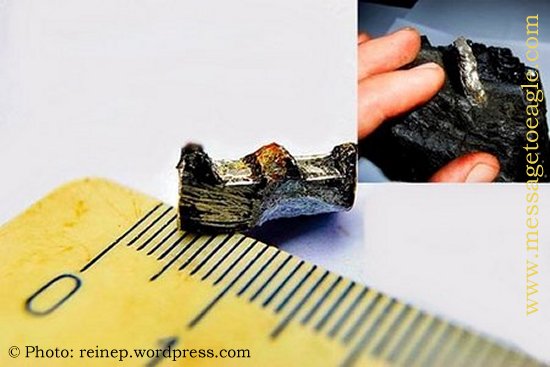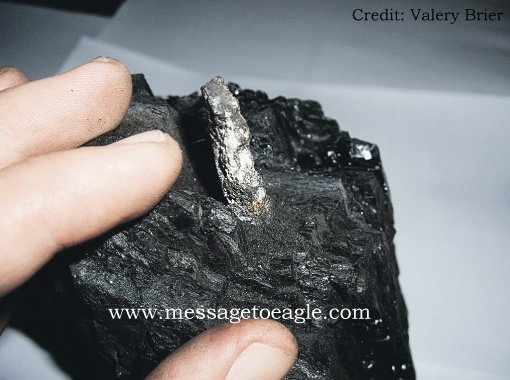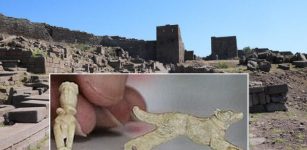Did Ancient Aliens Leave A 300-Million-Year-Old Aluminum Gear On Earth?
MessageToEaggle.com – This curious metal artifact has been studied by scientists who determined it to be 300-million-year-old.
The baffling object appears to be a part of some ancient machinery.
Who left this object on the Earth when the first land animals had yet to evolve into dinosaurs?
Did ancient aliens leave a 300-million-year-old aluminum gear on Earth? The material found in the object, particularly the 2 per cent magnesium, prompted speculations that the object could not have been of Earthly origin. The thought-provoking artifact was discovered in Vladivostok, Russia.
While lighting the fire during a cold winter evening a man named Dmitry, a resident of Vladivostok found a piece of a gear shift, a common machine part which was pressed in one of the pieces of coal that the man used to heat his home.
The object was so puzzling that Dmitry decided to contact biologist Valery Brier, in the seaside Primorye region.
Initial examination of the strange object led researchers to assert it looked “very much like a toothed metal rail, created artificially.
It was like parts [that] are often used in microscopes, various technical and electronic devices,” wrote Komsomolskaya Pravda.
The piece of coal in question originated from the Chernogorodskiy mines of the Khakasis region.
Scientists suggest that the object was not created by nature but was rather manufactured by someone.
The question of who might have made an aluminum gear in the dawn of time remains unanswered.
We have previously seen there are other artifacts that strongly challenge the evolutionary scenario.
In in 1889, workers in southwest Idaho discovered the Nampa figurine, an artifact skillfully formed in clay that has baffled scientists for many years.
In 1885, an iron smelter working in the foundry of the Austrian Isador Braun of Vocklabruck, Austria, discovered a small, cube-shaped piece of iron embedded in a block of coal dating to the Tertiary period lasting from approximately 65.5 million to 2.6 million years ago.
In 1851, an object that resembled a silver-zinc vase inlaid with fine silver in the form of the vine was discovered embedded within 15 feet of solid sedimentary rock. The age of this vase, according to the rock in which it found supposedly millions of years old.
A millennia old extremely complex object of unknown origin was also discovered in Romania.
In fact, there are so many such baffling discoveries and there is no doubt they have all undermined the most fundamental doctrines of modern science.
The machine-like object discovered in Vladivostok is yet another discovery which perplexed the scientists.
According to Voice of Russia, “the coal in which the metal object was pressed was delivered to Primorye from Chernogorodskiy mines of Khakasia region. Knowing that the coal deposits of this region date 300 million years back, Russian experts inferred that the metal detail found in these deposits must be an age-mate of the coal.
When geologists broke the piece of coal in which the metal object was pressed into and spot-treated in with special chemical agents, it turned out that the metal detail was unusually light and soft. No more than seven centimeters long, the object was found to be composed of 98 percent aluminum and 2 percent magnesium.
On the one hand, such an alloy stalled the scientists because nearly pure aluminum is very rarely found in nature. Thus, the detail was most definitely created artificially.
On the other hand, however, when it became clear that the object was made from aluminum-magnesium alloy the experts quickly found an answer to the question of how a metal detail could withstand the ravages of time so well.
The scientists explained that pure aluminum is increasingly prone to oxidization which contributes to the creation of a special layer protecting it from further corrosion. As a result, the metal detail made 98 percent from aluminum can endure not only high pressure but also heat and other severe natural conditions.
Another question that interests Russian scientists is whether the aluminum alloy is of Earthly origin.
It is known from the study of meteorites that there exists extra-terrestrial aluminum-26 which subsequently breaks down to magnesium-26.
The presence of 2 percent of magnesium in the alloy might well point to the alien origin of the aluminum detail.
Nonetheless, further testing is needed to confirm this hypothesis.
The last property of the object that puzzled the scientists was its distinctive shape which was reminiscent of a modern tooth-wheel. It is hard to imagine that an object could take regular shape of a tooth-wheel with six identical ‘teeth’ naturally.
Moreover, the intervals between the ‘teeth’ of the gear are curiously large in relation to the size of the ‘teeth’ themselves which might mean that the detail was a part of a complicated mechanism. Nowadays, such ‘spare parts’ are used in construction of microscopes and other mechanical appliances.
This poses yet another unanswerable question to the modern scientists: how can the metal tooth-wheel be 300 million years old if the regular-shaped ‘wheel’ itself was created by man millions of years later.”
Russian scientists say they will run further tests to learn more about this perplexing ancient artifact.
Copyright © MessageToEagle.com. All rights reserved. This material may not be published, broadcast, rewritten or redistributed in whole or part without the express written permission of MessageToEagle.com.












